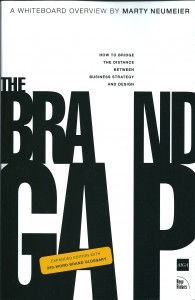The one-sentence summary
It is vital to bridge the gap between brand strategy and execution.
WHAT THE BOOK SAYS 
· This is all about how to bridge the distance between brand strategy and design (brand execution).
· In most companies this is separated by a chasm – left-brain strategists and marketing people on the one hand (analytical, logical, linear, concrete, numerical), and right-brain creative people on the other (intuitive, emotional, spatial, visual, physical).
· The Brand Gap can cause a brilliant strategy to fail where it counts most (at the point of contact with the customer), or it can doom a bold creative initiative before it’s even launched.
· The gap can be bridged by pursuing five areas:
1. Differentiate: who are you, what do you do, why does it matter?
2. Collaborate: it’s the survival of the fittingest. Specialists work best.
3. Innovate: design ignites passion, not strategy. Zag when others zig.
4. Validate: start a dialogue, and pay proper attention to feedback.
5. Cultivate: looking after brands is never-ending.
· The emphasis of marketing appeal has shifted from features (what it has) to benefits (what it does) to experience (what you’ll feel) to identification (who you are).
· Companies should appoint a CBO – a Chief Brand Officer – although such people are rare because they span the gap between right- and left-brain.
WHAT’S GOOD ABOUT IT
· Raymond Loewy espoused MAYA – the Most Advanced Yet Acceptable solution.
· All collaboration is ‘tidy in print but messy in practice.’. It takes hard work.
· The successful company is not the one with the most brains, but the one with the most brains acting in concert.
· Can’t be number one or two? Then redefine your category. Competition forces specialization – the survival of the fittingest.
· Turfismo is the behind-the-scenes politicking that ruins many initiatives.
· Featuritis is an infectious desire for more that overloads things (web pages, technology products) with far too much of everything.
· The Swap Test involves swapping part of your icon – the name or visual element – with that of a competitor. They should not be interchangeable, and if it looks better, there is room for improvement.
· The Hand Test: cover the logo of any piece of communication and try to work out who did it. If you don’t know, the branding isn’t strong enough.
· Edward de Bono suggested that, instead of USP (Unique Selling Proposition), brands should pay attention to UBS (Unique Buying State of their customers).
WHAT YOU HAVE TO WATCH
· Not much. It’s short and clear.
